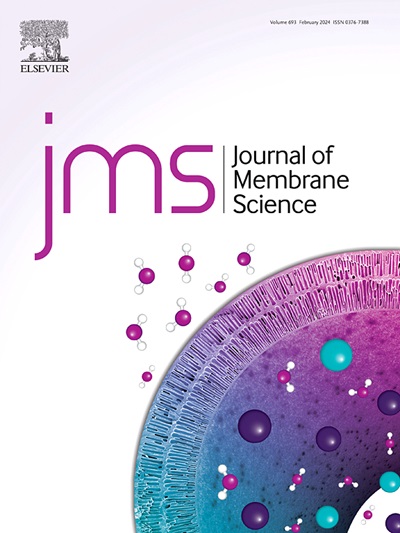Biomineralized metal-organic framework membrane with high-crystallinity for ultrafast molecular separation
IF 8.4
1区 工程技术
Q1 ENGINEERING, CHEMICAL
引用次数: 0
Abstract
Metal-organic frameworks (MOFs) possess uniform and controllable pore structure, holding significant promise for the creation of efficient molecular separation membranes. Nevertheless, the challenge lies in constructing MOF membranes with high crystallinity and effectively utilizing their ordered crystal channels for molecular separation. Drawing inspiration from natural biomineralization processes, an in-situ trace graphene oxide (GO)-mediated crystallization strategy was adopted here to manipulate the crystallization of Zr-MOF (MIP-202(Zr)) membranes. GO nanosheets with abundant oxygen-containing groups could interact with the MOF precursor, furnishing numerous growth sites for the subsequent MOF growth, thereby facilitating the crystallization process during membrane formation within only 60 min. The resultant GO/MIP-202(Zr) composite membrane, composed of highly crystalline MIP-202(Zr) and trace amount of GO nanosheets, overcame the trade-off between MOF crystallinity and membrane formation. Benefiting from the interconnected pore structure, the resulting GO/MIP-202(Zr) membrane presented ultrahigh water permeability (1698.9 L m−2 h−1 bar−1), surpassing that of the pure GO membrane (258.9 L m−2 h−1 bar−1) by 6.5 times, while maintaining a comparable rejection for common dye molecules. Furthermore, the membrane displayed satisfied recyclability and structural stability. This study provides important perspectives for the fabrication of advanced membranes derived from MOFs aimed at enhancing molecular separation processes.

求助全文
约1分钟内获得全文
求助全文
来源期刊

Journal of Membrane Science
工程技术-高分子科学
CiteScore
17.10
自引率
17.90%
发文量
1031
审稿时长
2.5 months
期刊介绍:
The Journal of Membrane Science is a publication that focuses on membrane systems and is aimed at academic and industrial chemists, chemical engineers, materials scientists, and membranologists. It publishes original research and reviews on various aspects of membrane transport, membrane formation/structure, fouling, module/process design, and processes/applications. The journal primarily focuses on the structure, function, and performance of non-biological membranes but also includes papers that relate to biological membranes. The Journal of Membrane Science publishes Full Text Papers, State-of-the-Art Reviews, Letters to the Editor, and Perspectives.
 求助内容:
求助内容: 应助结果提醒方式:
应助结果提醒方式:


